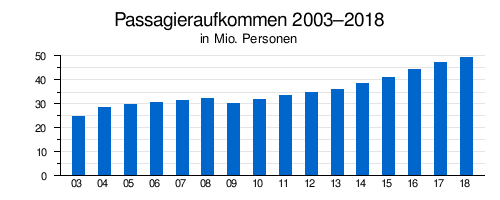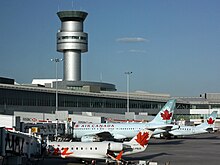Toronto Pearson Airport
| Toronto Pearson International Airport |
|
|---|---|

|
|
| Characteristics | |
| ICAO code | CYYZ |
| IATA code | YYZ |
| Coordinates | |
| Height above MSL | 173.43 m (569 ft ) |
| Transport links | |
| Distance from the city center | 20 km west of Toronto , 10 km north of Mississauga |
| Street | Ontario Highway 5 / 7 / 401 / 409 / 427 |
| train | UP Express |
| Local transport | bus |
| Basic data | |
| opening | 1939 |
| operator | Greater Toronto Airports Authority |
| surface | 1,897 ha |
| Terminals | 2 |
| Passengers | 49,507,418 (2018) |
| Air freight | 534,500 t (2017) |
| Flight movements |
474,304 (2018) |
| Capacity ( PAX per year) |
47 million |
| Employees | 49,000 (2017) |
| Runways | |
| 05/23 | 3389 m × 61 m asphalt / concrete |
| 06R / 24L | 2743 m × 61 m asphalt |
| 06L / 24R | 2956 m × 61 m asphalt |
| 15R / 33L | 2770 m × 61 m asphalt |
| 15L / 33R | 3368 m × 61 m asphalt |
The Toronto Pearson International Airport ( IATA code : YYZ , ICAO code : CYYZ ) is the international airport of the metropolitan region of Toronto in the Province of Ontario in Canada . With 49.5 million passengers in 2018, YYZ is Canada's largest airport (ahead of Vancouver ). The 1,867 hectare airport has a total of five runways (three in an east-west direction, two in a north-south direction). It was named after Lester B. Pearson , the former Prime Minister of Canada.
Location and transport links
The Toronto Pearson International Airport is almost entirely in the area of the city of Mississauga , about 20 kilometers west of downtown Toronto
The airport is connected to the road network on the east side (towards Toronto). Access is from the airport exits on Highway 427 and Highway 409, which leads directly to the airport . Another access is the 4-lane city street Dixon Road , which becomes Airport Road in the airport area .
The TTC bus line 192 Airport Rocket runs every 10 minutes to the Kipling terminus of the Toronto Subway (2017 fee: CAN $ 3.15). From there, Toronto Union Station can be reached with one change. The entire journey takes about 60 minutes and costs 11 CAN $ (2015) with a TTC day pass. Other buses run from the airport to the nearby stations of the surrounding local transport networks.
The car rental stations are located in the parking garages of the two terminals and in the Viscount parking garage . Taxis and limousines (more luxurious taxis) are available at the arrivals level . A one-way taxi ride to the city center costs CAN $ 53 (2015). Private bus companies with minibuses (Out-of Town Van Service, Shuttle Bus) open up the surrounding area as far as Detroit and Buffalo . The schedule ranges from once a day to every hour.
On June 6, 2015, the airport was connected to the railway network. The Union Pearson Express (UP Express) runs every 15 minutes with a journey time of 25 minutes from Terminal 1 via the Bloor and Weston train stations to Toronto Union Station .
Meaning and history
About 65 airlines offer connections to 25 Canadian, 43 US and 42 international destinations. In addition, the airport is used by various cargo airlines. It is a hub for the airline Air Canada . 49,000 employees work at the airport.
The airport is owned by the Canadian state and operated by the Greater Toronto Airports Authority (GTAA) (the previous operating company was Transport Canada ).
The airport opened as Malton Airport in 1939 . In 1960 it was renamed Toronto International Airport and in 1984 it was renamed Lester B. Pearson International Airport (LBPIA). Originally, the airport was located in a predominantly agricultural area. It is now completely surrounded by the buildings and infrastructure of the Toronto metropolitan area.
Terminals and Airlines
Toronto Pearson International Airport has two passenger terminals : Terminal 1 and Terminal 3. (The two terminals are not numbered consecutively because the original Terminals 1 and 2 have been replaced by the new Terminal 1.) Both terminals have departures above the arrivals level. Each level has a public driveway. In Terminal 1, ground transportation takes place below the arrivals level.
For flight connections to the USA, there is a transit area with US customs and immigration controls, the so-called Border Preclearance (see border between Canada and the United States ).
The LINK Train , a free-to-use cable car with three stations, connects the two terminals and the Viscount car park .
Star Alliance flights (including Air Canada, Lufthansa ) are handled in Terminal 1.
Air Canada and Lufthansa fly to Frankfurt am Main and Munich , Austrian Airlines to Vienna , Air Canada to Berlin-Tegel , Geneva and Zurich and Condor to Frankfurt am Main during the summer season.
Traffic figures


| year | Passenger volume | Air freight ( tons ) (with airmail) |
Aircraft movements ( with military) |
||
|---|---|---|---|---|---|
| National | International | total | |||
| 2018 | 17.860.337 | 31,647,081 | 49.507.418 | 474304 | |
| 2017 | 17,475,217 | 29,655,141 | 47.130.358 | 534,500 | 465,574 |
| 2016 | 16,906,560 | 27,428,638 | 44.335.198 | 472,300 | 456.536 |
| 2015 | 15,859,289 | 25.177.558 | 41,036,847 | 433,900 | 443,958 |
| 2014 | 15.192.126 | 23.380.290 | 38,572,416 | 448,600 | 434,644 |
| 2013 | 14,385,445 | 21,724,024 | 36,109,469 | 411,300 | 432.209 |
| 2012 | 13,646,163 | 21,265,866 | 34,912,029 | 417,000 | 433.010 |
| 2011 | 13,078,513 | 20,356,764 | 33.435.277 | 418,700 | 428.477 |
| 2010 | 12,730,680 | 19.205.418 | 31,936,098 | 447,300 | 418.298 |
| 2009 | 12,730,047 | 17,638,292 | 30,368,339 | - | 407.352 |
| 2008 | 13,812,866 | 18,521,965 | 32,334,831 | - | 430,588 |
| 2007 | 13,744,155 | 17,702,044 | 31.446.199 | 505,000 | 425,500 |
| 2006 | 13,309,531 | 17,485,050 | 30,794,581 | 505,000 | 417.932 |
| 2005 | 12,906,457 | 17.008.293 | 29,914,750 | - | 409,401 |
| 2004 | 12,636,748 | 15,979,233 | 28,615,981 | - | 403.778 |
| 2003 | 11,021,760 | 13,717,552 | 24,739,312 | - | 370.996 |
| 2002 | - | - | - | - | 383.189 |
| 2001 | - | - | - | - | 406.360 |
| 2000 | - | - | - | - | 426.506 |
Incidents
- The worst accident at the airport occurred on July 5, 1970, when a Douglas DC-8 crashed on Air Canada Flight 621 ; 100 passengers and nine crew members died.
- On June 26, 1978 came McDonnell Douglas DC-9 of Air Canada after an aborted start only in a creek behind the runway to a halt; two of 102 passengers died.
- On August 2, 2005, rolled over Airbus A340-300 of Air France , Flight No. 358th in a storm the runway end and got into the same creek; 43 people were injured and the plane burned down completely.
- On January 5, 2018, two Boeing 737-800s operated by Sunwing Airlines and Westjet Airlines collided on the ground . As a result, there was a fire on the Sunwing Airlines plane.
Trivia
The Canadian rock band Rush dedicated the song YYZ to the airport.
See also
Web links
- Official Site of Toronto Pearson International Airport (English / French)
- Official website of the Greater Toronto Airports Authority (English / French)
- Toronto Pearson Airport information page
- GTAA news releases
- Airport data (English)
- CBS News Special Report, Air France Flight 358 Crashes in Toronto, Ontario, Canada with WMP or RealPlayer
- Practical information for passengers to Pearson Airport in Toronto (German)
Individual evidence
- ↑ a b c master plan. TorontoPearson.com, accessed August 16, 2018 .
- ↑ a b c d e f Statistics. TorontoPearson.com, accessed March 29, 2019 .
- ↑ a b c d Annual Reports. TorontoPearson.com, accessed August 16, 2018 .
- ^ Airlines and Destinations. TorontoPearson.com, accessed March 29, 2019 .
- ↑ Canada's insufficient slopes. aeroTELEGRAPH.com, September 25, 2011, accessed on August 16, 2018 (German).
- ^ Fire after ground collision in Toronto. aeroTELEGRAPH.com, January 6, 2018, accessed on August 16, 2018 (German).
- ↑ Sunwing plane catches fire after clipping WestJet aircraft at Toronto's Pearson airport. GlobalNews.ca , January 5, 2018, accessed August 16, 2018 .
- ↑ Documentation: Rush - Beyond the Lighted Stage




